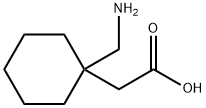Gabapentin: Pharmacokinetics, Clinical Uses in Dermatology and Dosage
Apr 29,2024
General Description
Gabapentin, with its straightforward pharmacokinetics characterized by renal excretion and linear elimination kinetics, is a valuable asset in dermatology. It is effective in managing neuropathic conditions like postherpetic neuralgia, neuralgias in various body areas, and pruritus. The medication's mechanism of action involves inhibiting calcium ion channels and enhancing GABA synthesis. Gabapentin also shows promise in treating chronic pain syndromes, allodynia, and reflex sympathetic dystrophy. The recommended dosage of Gabapentin typically starts at 300 mg daily, gradually increasing to 1200 mg thrice daily. Adherence to prescribed dosages and gradual tapering during discontinuation are crucial for optimal therapeutic outcomes.

Figure 1. Gabapentin
Pharmacokinetics
Gabapentin exhibits straightforward pharmacokinetics. It undergoes minimal metabolism and is primarily eliminated through renal excretion in an unchanged form. Unlike some medications, it does not stimulate hepatic enzymes. Absorption of gabapentin is nonlinear and dependent on dosage, particularly at very high doses, yet its elimination kinetics remain linear. Notably, gabapentin does not bind to plasma proteins, resulting in negligible drug interactions. Its relatively short half-life, typically ranging from 5.0 to 8.0 hours, necessitates frequent dosing, typically administered two or three times daily. Due to its pharmacokinetic profile, dose adjustments should be made gradually to ensure optimal therapeutic effects while minimizing adverse reactions. Overall, understanding gabapentin's pharmacokinetics aids in its appropriate dosing regimen and management in clinical settings. 1
Clinical Uses in Dermatology
Gabapentin, a medication primarily known for its anticonvulsant properties, has found extensive clinical utility in dermatology, particularly in the management of various neuropathic conditions and pruritus. In the realm of postherpetic neuralgia and similar neuropathies, Gabapentin has demonstrated efficacy in reducing average daily pain in patients, improving sleep, and enhancing overall quality of life. It is the first oral medication approved in the USA for postherpetic neuralgia. Moreover, Gabapentin has shown positive outcomes in treating neuralgia in different areas of the body, including trigeminal neuralgia, glossopharyngeal neuralgia, and facial neuritis. It is also effective in inflammatory pain and neuropathic conditions such as HIV neuropathy and diabetic neuropathic pain. In the context of pruritus, Gabapentin has emerged as an effective antipruritic agent in various conditions like uremic pruritus, brachioradial pruritus, and pruritus associated with wound healing. Its mechanism of action involves inhibiting voltage-dependent calcium ion channels in the spinal cord, increasing the synthesis of γ-aminobutyric acid, and inhibiting the release of itch mediators, thereby raising the threshold for experiencing nociception. Pregabalin, a related drug, has also shown efficacy in treating pruritus in different dermatological conditions. Additionally, Gabapentin has been beneficial in managing chronic, focal pain syndromes known as "dynias," as well as conditions like allodynia and reflex sympathetic dystrophy. It has demonstrated positive outcomes in pain related to leiomyomas, vasolabile conditions, erythromelalgia, and various neurologic problems affecting the skin. Furthermore, Gabapentin has shown promise in improving pain control during wound dressing in cancer patients and addressing toxic epidermal necrolysis-related pain. In summary, Gabapentin's diverse mechanisms of action make it a valuable asset in the dermatologist's armamentarium for treating a wide array of neuropathic conditions, pruritus, and chronic pain syndromes affecting the skin and nervous system. 2
Dosage
Gabapentin, a medication commonly prescribed for various neurological conditions, has a recommended dosage regimen. Initially, patients typically start with a daily dose of 300 mg, which can then be increased gradually up to 1200 mg three times a day. Unlike some medications that require a gradual titration upwards, gabapentin can be initiated at its effective dose. However, discontinuation of gabapentin should not be abrupt but rather tapered gradually to avoid withdrawal-related side effects. Notably, gabapentin has a high toxicity ratio, reducing the likelihood of adverse effects even in cases of high overdoses. Due to this, routine monitoring of clinical laboratory parameters is not deemed necessary. It's important to adhere to the prescribed dosage and follow the guidance of a healthcare professional when using gabapentin. In comparison, pregabalin, another medication with similar indications, typically starts at an initial dose of 150 mg per day, with the possibility of increasing up to 600 mg per day. 2
Reference
1. Bockbrader HN, Wesche D, Miller R, Chapel S, Janiczek N, Burger P. A comparison of the pharmacokinetics and pharmacodynamics of pregabalin and gabapentin. Clin Pharmacokinet. 2010; 49(10): 661-669.
2. Mittal A, Agarwal C, Balai M, Taneja A. Gabapentin and pregabalin in dermatology. Indian J Dermatol Venereol Leprol. 2018; 84(5): 634-640.
- Related articles
- Related Qustion
- Exploring the Mechanisms, Applications, and Risks of Gabapentin: A Comprehensive Overview Jan 5, 2024
Gabapentin is an analgesic for neuropathic pain, acting through VGCC inhibition and disruption of α2δ-1-NMDAR complexes. Side effects include breathing problems, mood changes, and drowsiness.
- A off-label used drug: Gabapentin Oct 8, 2023
Gabapentin is a widely prescribed medication used primarily for the treatment of epilepsy and neuropathic pain.
- Uses and Adverse effect of Gabapentin Feb 28, 2022
Gabapentin is a structural analogue of the inhibitory neurotransmitter gamma-aminobutyric acid (GABA) that was first approved for use in the United States in 1993 (1) It was originally developed as a novel anti-epileptic for the treatment o
One of the most promising developments in this area is Tildacerfont, a novel therapy designed to combat hypercortisolism.....
Apr 29,2024APILimited data on Tolylene-2,4-diisocyanate complicates dermal exposure assessment. Respiratory effects and carcinogenicity risks are evident, but uncertainties persist.....
Apr 29,2024APIGabapentin
60142-96-3You may like
- Gabapentin
-

- $362.00 / 1kg
- 2024-06-04
- CAS:60142-96-3
- Min. Order: 1kg
- Purity: 99.99%
- Supply Ability: 100Tons
- Gabapentin
-

- $225.00 / 1Kg/Bag
- 2024-06-04
- CAS:60142-96-3
- Min. Order: 1Kg/Bag
- Purity: USP
- Supply Ability: 20 tons
- Gabapentin
-

- $1.00 / 1ASSAYS
- 2024-06-04
- CAS:60142-96-3
- Min. Order: 1ASSAYS
- Purity: 99%
- Supply Ability: 1kg




